Updated:
18 January 2015
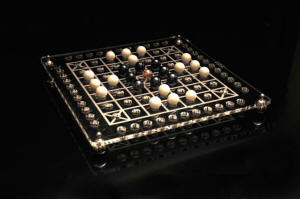 The board games offered here will grace your
home as objects, providing interesting
conversation and challenging entertainment for family
and friends.
A tactile antidote to this virtual world of
computer games.
The four games that we have re-created, all have origins
dating to pre-christian times. Ard Ri, Fox and Geese
(Halatafl) and
Hnefatafl are from Norse Viking culture and are games of
stratergy that mimic battle situations of attack and defence
in both campaign and hand to hand fighting. In Viking culture, a leader's status
was raised through his skill at playing these games.
Nobody knows exactly how these board games
were originally played as they all come from a period
when information was passed down by word of mouth and
little or nothing was written down. Through acheological
and academic research, it is only within the last
century that any kind of concensus has been reached
although,
even now there is still a great deal of discussion on
the subject.
For our purposes, we have taken what seems to be
the concensus. We may be right or we may be
wrong. Either way they are challenging and great fun to
play and, as nothing is certain, the rules can be
adapted without too much fear of retribution.
Fox and Geese
The board games offered here will grace your
home as objects, providing interesting
conversation and challenging entertainment for family
and friends.
A tactile antidote to this virtual world of
computer games.
The four games that we have re-created, all have origins
dating to pre-christian times. Ard Ri, Fox and Geese
(Halatafl) and
Hnefatafl are from Norse Viking culture and are games of
stratergy that mimic battle situations of attack and defence
in both campaign and hand to hand fighting. In Viking culture, a leader's status
was raised through his skill at playing these games.
Nobody knows exactly how these board games
were originally played as they all come from a period
when information was passed down by word of mouth and
little or nothing was written down. Through acheological
and academic research, it is only within the last
century that any kind of concensus has been reached
although,
even now there is still a great deal of discussion on
the subject.
For our purposes, we have taken what seems to be
the concensus. We may be right or we may be
wrong. Either way they are challenging and great fun to
play and, as nothing is certain, the rules can be
adapted without too much fear of retribution.
Fox and Geese
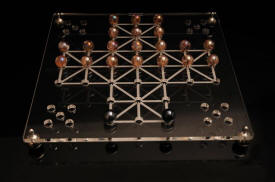 The four games that we have re-created, all have origins
dating to
Fox & Geese is a Scandinavian game, being mentioned in
the Icelandic Gretis Sagas of the 14th century, that
spread through Europe, wherever the vikings had contact.
There became many varients such as Wolf and Sheep, Fox
and Hounds, Devil and Tailors etc., with many different rules and
objectives.
It is played on the Halatafl board, meaning ‘tail board’
in old Norse, possibly from the foxes tail handle that
have been found on archeological excavations.
In this game there are 20 geese and 2 foxes, although it
can also be played with 13 geese and 1 fox. There are
enough playing pieces with this game to allow you to
choose your own varient.
The four games that we have re-created, all have origins
dating to
Fox & Geese is a Scandinavian game, being mentioned in
the Icelandic Gretis Sagas of the 14th century, that
spread through Europe, wherever the vikings had contact.
There became many varients such as Wolf and Sheep, Fox
and Hounds, Devil and Tailors etc., with many different rules and
objectives.
It is played on the Halatafl board, meaning ‘tail board’
in old Norse, possibly from the foxes tail handle that
have been found on archeological excavations.
In this game there are 20 geese and 2 foxes, although it
can also be played with 13 geese and 1 fox. There are
enough playing pieces with this game to allow you to
choose your own varient.
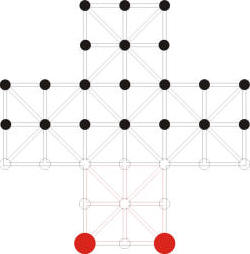 The object of the game is for the geese to hem the foxes
in and get 9 of the geese to the safety of the 9 hole
wing of the board opposite their starting positions, and
the foxes to try and stop them.
The geese may only move ahead or sideways by one hole
and are non aggressive so they can’t take the foxes.
The foxes may move in any direction by one hole, and
kill a goose by jumping over it. If the opportunity
arises, they must take the goose, and may take more than
one in one turn.
There are many variants of this game, but we think this
configuration is probably the most balanced.
Buy Now
Return to Top of Page
Hnefatafl Board
Of Norse origin, two different games can be played on this board and we
provide enough playing pieces for you to play either of
them.
Ard Ri, meaning high
king, is the Scottish version of one of the Norse
halatafl games. There are also known to be versions from
Irish and Welsh culture.
The object of the game is for the geese to hem the foxes
in and get 9 of the geese to the safety of the 9 hole
wing of the board opposite their starting positions, and
the foxes to try and stop them.
The geese may only move ahead or sideways by one hole
and are non aggressive so they can’t take the foxes.
The foxes may move in any direction by one hole, and
kill a goose by jumping over it. If the opportunity
arises, they must take the goose, and may take more than
one in one turn.
There are many variants of this game, but we think this
configuration is probably the most balanced.
Buy Now
Return to Top of Page
Hnefatafl Board
Of Norse origin, two different games can be played on this board and we
provide enough playing pieces for you to play either of
them.
Ard Ri, meaning high
king, is the Scottish version of one of the Norse
halatafl games. There are also known to be versions from
Irish and Welsh culture.
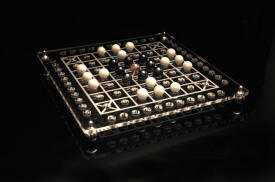 At the beginning of play, the king is placed on the
center square of the board (the throne) and his
defenders are located at the four sides surrounding the
king
The opposing attackers reside around the perimeter
squares in four phalanx formations.
The object of the game is to get the king to occupy any
square on the edge of the board. The opposing attackers
try to capture the king.
Each player can move only one piece per move and all
pieces move the same way - one square horizontally or
vertically with the following conditions:-
At the beginning of play, the king is placed on the
center square of the board (the throne) and his
defenders are located at the four sides surrounding the
king
The opposing attackers reside around the perimeter
squares in four phalanx formations.
The object of the game is to get the king to occupy any
square on the edge of the board. The opposing attackers
try to capture the king.
Each player can move only one piece per move and all
pieces move the same way - one square horizontally or
vertically with the following conditions:-
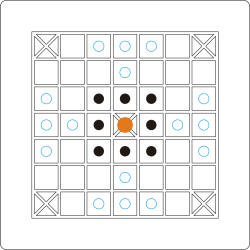 Only one piece can stand on each square
After the king leaves the throne, no piece can move to
the throne. However, the king may return to the throne
if desired.
How to capture the opponent's pieces :-
Captured pieces are removed from the board.
Each player can capture the opponent’s pieces by
“sandwiching” or “flanking” an opposing piece either
vertically or horizontally between two of the capturing
pieces.
If a player moves a piece between two opponent's pieces,
the piece is not captured.
The king CAN take part in capturing his adversaries,
whether he is the moving piece OR not. This attribute is
only for defenders and attackers.
To capture the king, the attackers have to surround the
king from all four sides - the four cardinal points. At
which point the game is ended with the attackers'
victory.
The king may not be captured against the throne, since
he can move onto it and the defending player wins the
game.
Where a player is not able to make a legal move. This
player loses the game
Another variation is for the king to try and make it to
the safety of one of the four castles in the corners of
the board.
Only one piece can stand on each square
After the king leaves the throne, no piece can move to
the throne. However, the king may return to the throne
if desired.
How to capture the opponent's pieces :-
Captured pieces are removed from the board.
Each player can capture the opponent’s pieces by
“sandwiching” or “flanking” an opposing piece either
vertically or horizontally between two of the capturing
pieces.
If a player moves a piece between two opponent's pieces,
the piece is not captured.
The king CAN take part in capturing his adversaries,
whether he is the moving piece OR not. This attribute is
only for defenders and attackers.
To capture the king, the attackers have to surround the
king from all four sides - the four cardinal points. At
which point the game is ended with the attackers'
victory.
The king may not be captured against the throne, since
he can move onto it and the defending player wins the
game.
Where a player is not able to make a legal move. This
player loses the game
Another variation is for the king to try and make it to
the safety of one of the four castles in the corners of
the board.
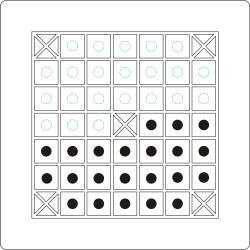 Hnefatafl
is a Viking game, which emulates close quarters fighting
of a medieval battle situation. Each man faces an
adversary in the enemy army and it is also against this
man he will strike. The men cannot go backwards
because retreating men could cause chaos and catastrophe
as
the lines would break up.
However, the men would be able to capture backwards
because
an enemy behind your back cannot be ignored. The
object of a battle is not just the killing of
men, it could be the capture of a castle.
This game provides such an objective in the two
"castles" in the form of the crossed corner squares.
The object for both parties is to reach any of the two
corners of the board located behind the enemy forces.
The pieces move one step forwards or sideways, but not
backwards. However, capturing backwards is allowed.
Only forwards, sideways or backwards capture is allowed.
If an adjacent square is occupied by an enemy piece and
the square directly behind is vacant, then the piece
must jump over it and capture it. Failure to capture results in the offending
piece being removed from play. Several pieces may be
captured like this in a single turn. Should a player put
a piece in his own corner, then he loses. However,
jumping via one's own corner does not lose.
Buy Now
Return to Top of Page
Nimm
Hnefatafl
is a Viking game, which emulates close quarters fighting
of a medieval battle situation. Each man faces an
adversary in the enemy army and it is also against this
man he will strike. The men cannot go backwards
because retreating men could cause chaos and catastrophe
as
the lines would break up.
However, the men would be able to capture backwards
because
an enemy behind your back cannot be ignored. The
object of a battle is not just the killing of
men, it could be the capture of a castle.
This game provides such an objective in the two
"castles" in the form of the crossed corner squares.
The object for both parties is to reach any of the two
corners of the board located behind the enemy forces.
The pieces move one step forwards or sideways, but not
backwards. However, capturing backwards is allowed.
Only forwards, sideways or backwards capture is allowed.
If an adjacent square is occupied by an enemy piece and
the square directly behind is vacant, then the piece
must jump over it and capture it. Failure to capture results in the offending
piece being removed from play. Several pieces may be
captured like this in a single turn. Should a player put
a piece in his own corner, then he loses. However,
jumping via one's own corner does not lose.
Buy Now
Return to Top of Page
Nimm
 Nimm is a medieval game from the 15th century, deriving
from the germanic word nimm meaning ‘take’ or from the
obsolete Old English verb nim, also
meaning ‘to take’. It is thought that the game may have
been brought to the north by the Romans.
The game involves setting up 15 ‘men’ in lines of 5, 4,
3, 2, and 1.
Decide before play whether the winner or loser will be
the last to remove the final man from the board.
Two players alternately remove either a whole line, or
part of a line, whichever they like.
Nimm is a medieval game from the 15th century, deriving
from the germanic word nimm meaning ‘take’ or from the
obsolete Old English verb nim, also
meaning ‘to take’. It is thought that the game may have
been brought to the north by the Romans.
The game involves setting up 15 ‘men’ in lines of 5, 4,
3, 2, and 1.
Decide before play whether the winner or loser will be
the last to remove the final man from the board.
Two players alternately remove either a whole line, or
part of a line, whichever they like.
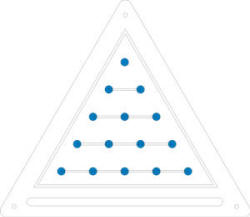 Any remaining pieces of a line, which has been partly
removed, may only be taken one piece at a time.
The player to remove the final piece is either the
winner or loser as decided before the start of play.
A deceptively simple game with endless possibilities,
and many variations.
Buy Now
Return to Top of Page
Alquerque
Alquerque, also known as el Qirkat, is one of the oldest
known board games and goes back as far back as 1400 BC.
Brought to Europe by the Moors, via Spain, it’s history
can be traced from Egyptian times.
Any remaining pieces of a line, which has been partly
removed, may only be taken one piece at a time.
The player to remove the final piece is either the
winner or loser as decided before the start of play.
A deceptively simple game with endless possibilities,
and many variations.
Buy Now
Return to Top of Page
Alquerque
Alquerque, also known as el Qirkat, is one of the oldest
known board games and goes back as far back as 1400 BC.
Brought to Europe by the Moors, via Spain, it’s history
can be traced from Egyptian times.
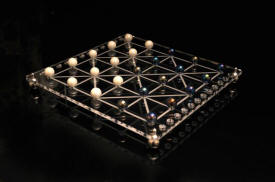 The first written mention of Alquerque are from the
10th century in the Kitab al-Aghani (“Book of Songs”)
and the 13th century in the Libro de los juegos (“Book
of Games”). Both sources tell us a lot about the game,
but there are still some open questions.
The game is a bit like modern draughts, played on a
board with a grid, where the two players move their 12
pieces, Alqueeple, across the board.
The object of the game is to eliminate as many of the
opponent’s pieces as possible.
The first written mention of Alquerque are from the
10th century in the Kitab al-Aghani (“Book of Songs”)
and the 13th century in the Libro de los juegos (“Book
of Games”). Both sources tell us a lot about the game,
but there are still some open questions.
The game is a bit like modern draughts, played on a
board with a grid, where the two players move their 12
pieces, Alqueeple, across the board.
The object of the game is to eliminate as many of the
opponent’s pieces as possible.
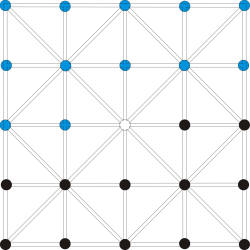 At the start of the game the two players place their
pieces in the two rows closest to them and on the two
rightmost spaces in the centre row. Now the players take
turns moving their pieces. A piece can move along the
lines to the next free crossing, or if there’s an
opposing piece with a free point next to it, the piece
can “jump” over the other piece to the next adjacent
point and remove the opposing piece from the game. If
there are more opposing pieces that can be captured by
the same piece, it’s compulsory to keep “jumping” –
should the player miss a change to remove an opposing
piece, his own piece is removed (that is if he just
moved a piece to a free space, but could have caught an
opposing piece with this or another of his pieces). The
move ends when there’s no possibility to jump any more
for this piece.
Buy Now
Return to Top of Page
At the start of the game the two players place their
pieces in the two rows closest to them and on the two
rightmost spaces in the centre row. Now the players take
turns moving their pieces. A piece can move along the
lines to the next free crossing, or if there’s an
opposing piece with a free point next to it, the piece
can “jump” over the other piece to the next adjacent
point and remove the opposing piece from the game. If
there are more opposing pieces that can be captured by
the same piece, it’s compulsory to keep “jumping” –
should the player miss a change to remove an opposing
piece, his own piece is removed (that is if he just
moved a piece to a free space, but could have caught an
opposing piece with this or another of his pieces). The
move ends when there’s no possibility to jump any more
for this piece.
Buy Now
Return to Top of Page
Ancient Board Games
Stylishly Recreated For The Modern Setting The board games offered here will grace your
home as objects, providing interesting
conversation and challenging entertainment for family
and friends.
A tactile antidote to this virtual world of
computer games.
The four games that we have re-created, all have origins
dating to pre-christian times. Ard Ri, Fox and Geese
(Halatafl) and
Hnefatafl are from Norse Viking culture and are games of
stratergy that mimic battle situations of attack and defence
in both campaign and hand to hand fighting. In Viking culture, a leader's status
was raised through his skill at playing these games.
Nobody knows exactly how these board games
were originally played as they all come from a period
when information was passed down by word of mouth and
little or nothing was written down. Through acheological
and academic research, it is only within the last
century that any kind of concensus has been reached
although,
even now there is still a great deal of discussion on
the subject.
For our purposes, we have taken what seems to be
the concensus. We may be right or we may be
wrong. Either way they are challenging and great fun to
play and, as nothing is certain, the rules can be
adapted without too much fear of retribution.
Fox and Geese
The board games offered here will grace your
home as objects, providing interesting
conversation and challenging entertainment for family
and friends.
A tactile antidote to this virtual world of
computer games.
The four games that we have re-created, all have origins
dating to pre-christian times. Ard Ri, Fox and Geese
(Halatafl) and
Hnefatafl are from Norse Viking culture and are games of
stratergy that mimic battle situations of attack and defence
in both campaign and hand to hand fighting. In Viking culture, a leader's status
was raised through his skill at playing these games.
Nobody knows exactly how these board games
were originally played as they all come from a period
when information was passed down by word of mouth and
little or nothing was written down. Through acheological
and academic research, it is only within the last
century that any kind of concensus has been reached
although,
even now there is still a great deal of discussion on
the subject.
For our purposes, we have taken what seems to be
the concensus. We may be right or we may be
wrong. Either way they are challenging and great fun to
play and, as nothing is certain, the rules can be
adapted without too much fear of retribution.
Fox and Geese
 The four games that we have re-created, all have origins
dating to
Fox & Geese is a Scandinavian game, being mentioned in
the Icelandic Gretis Sagas of the 14th century, that
spread through Europe, wherever the vikings had contact.
There became many varients such as Wolf and Sheep, Fox
and Hounds, Devil and Tailors etc., with many different rules and
objectives.
It is played on the Halatafl board, meaning ‘tail board’
in old Norse, possibly from the foxes tail handle that
have been found on archeological excavations.
In this game there are 20 geese and 2 foxes, although it
can also be played with 13 geese and 1 fox. There are
enough playing pieces with this game to allow you to
choose your own varient.
The four games that we have re-created, all have origins
dating to
Fox & Geese is a Scandinavian game, being mentioned in
the Icelandic Gretis Sagas of the 14th century, that
spread through Europe, wherever the vikings had contact.
There became many varients such as Wolf and Sheep, Fox
and Hounds, Devil and Tailors etc., with many different rules and
objectives.
It is played on the Halatafl board, meaning ‘tail board’
in old Norse, possibly from the foxes tail handle that
have been found on archeological excavations.
In this game there are 20 geese and 2 foxes, although it
can also be played with 13 geese and 1 fox. There are
enough playing pieces with this game to allow you to
choose your own varient.
 The object of the game is for the geese to hem the foxes
in and get 9 of the geese to the safety of the 9 hole
wing of the board opposite their starting positions, and
the foxes to try and stop them.
The geese may only move ahead or sideways by one hole
and are non aggressive so they can’t take the foxes.
The foxes may move in any direction by one hole, and
kill a goose by jumping over it. If the opportunity
arises, they must take the goose, and may take more than
one in one turn.
There are many variants of this game, but we think this
configuration is probably the most balanced.
Buy Now
Return to Top of Page
Hnefatafl Board
Of Norse origin, two different games can be played on this board and we
provide enough playing pieces for you to play either of
them.
Ard Ri, meaning high
king, is the Scottish version of one of the Norse
halatafl games. There are also known to be versions from
Irish and Welsh culture.
The object of the game is for the geese to hem the foxes
in and get 9 of the geese to the safety of the 9 hole
wing of the board opposite their starting positions, and
the foxes to try and stop them.
The geese may only move ahead or sideways by one hole
and are non aggressive so they can’t take the foxes.
The foxes may move in any direction by one hole, and
kill a goose by jumping over it. If the opportunity
arises, they must take the goose, and may take more than
one in one turn.
There are many variants of this game, but we think this
configuration is probably the most balanced.
Buy Now
Return to Top of Page
Hnefatafl Board
Of Norse origin, two different games can be played on this board and we
provide enough playing pieces for you to play either of
them.
Ard Ri, meaning high
king, is the Scottish version of one of the Norse
halatafl games. There are also known to be versions from
Irish and Welsh culture.
 At the beginning of play, the king is placed on the
center square of the board (the throne) and his
defenders are located at the four sides surrounding the
king
The opposing attackers reside around the perimeter
squares in four phalanx formations.
The object of the game is to get the king to occupy any
square on the edge of the board. The opposing attackers
try to capture the king.
Each player can move only one piece per move and all
pieces move the same way - one square horizontally or
vertically with the following conditions:-
At the beginning of play, the king is placed on the
center square of the board (the throne) and his
defenders are located at the four sides surrounding the
king
The opposing attackers reside around the perimeter
squares in four phalanx formations.
The object of the game is to get the king to occupy any
square on the edge of the board. The opposing attackers
try to capture the king.
Each player can move only one piece per move and all
pieces move the same way - one square horizontally or
vertically with the following conditions:-
 Only one piece can stand on each square
After the king leaves the throne, no piece can move to
the throne. However, the king may return to the throne
if desired.
How to capture the opponent's pieces :-
Captured pieces are removed from the board.
Each player can capture the opponent’s pieces by
“sandwiching” or “flanking” an opposing piece either
vertically or horizontally between two of the capturing
pieces.
If a player moves a piece between two opponent's pieces,
the piece is not captured.
The king CAN take part in capturing his adversaries,
whether he is the moving piece OR not. This attribute is
only for defenders and attackers.
To capture the king, the attackers have to surround the
king from all four sides - the four cardinal points. At
which point the game is ended with the attackers'
victory.
The king may not be captured against the throne, since
he can move onto it and the defending player wins the
game.
Where a player is not able to make a legal move. This
player loses the game
Another variation is for the king to try and make it to
the safety of one of the four castles in the corners of
the board.
Only one piece can stand on each square
After the king leaves the throne, no piece can move to
the throne. However, the king may return to the throne
if desired.
How to capture the opponent's pieces :-
Captured pieces are removed from the board.
Each player can capture the opponent’s pieces by
“sandwiching” or “flanking” an opposing piece either
vertically or horizontally between two of the capturing
pieces.
If a player moves a piece between two opponent's pieces,
the piece is not captured.
The king CAN take part in capturing his adversaries,
whether he is the moving piece OR not. This attribute is
only for defenders and attackers.
To capture the king, the attackers have to surround the
king from all four sides - the four cardinal points. At
which point the game is ended with the attackers'
victory.
The king may not be captured against the throne, since
he can move onto it and the defending player wins the
game.
Where a player is not able to make a legal move. This
player loses the game
Another variation is for the king to try and make it to
the safety of one of the four castles in the corners of
the board.
 Hnefatafl
is a Viking game, which emulates close quarters fighting
of a medieval battle situation. Each man faces an
adversary in the enemy army and it is also against this
man he will strike. The men cannot go backwards
because retreating men could cause chaos and catastrophe
as
the lines would break up.
However, the men would be able to capture backwards
because
an enemy behind your back cannot be ignored. The
object of a battle is not just the killing of
men, it could be the capture of a castle.
This game provides such an objective in the two
"castles" in the form of the crossed corner squares.
The object for both parties is to reach any of the two
corners of the board located behind the enemy forces.
The pieces move one step forwards or sideways, but not
backwards. However, capturing backwards is allowed.
Only forwards, sideways or backwards capture is allowed.
If an adjacent square is occupied by an enemy piece and
the square directly behind is vacant, then the piece
must jump over it and capture it. Failure to capture results in the offending
piece being removed from play. Several pieces may be
captured like this in a single turn. Should a player put
a piece in his own corner, then he loses. However,
jumping via one's own corner does not lose.
Buy Now
Return to Top of Page
Nimm
Hnefatafl
is a Viking game, which emulates close quarters fighting
of a medieval battle situation. Each man faces an
adversary in the enemy army and it is also against this
man he will strike. The men cannot go backwards
because retreating men could cause chaos and catastrophe
as
the lines would break up.
However, the men would be able to capture backwards
because
an enemy behind your back cannot be ignored. The
object of a battle is not just the killing of
men, it could be the capture of a castle.
This game provides such an objective in the two
"castles" in the form of the crossed corner squares.
The object for both parties is to reach any of the two
corners of the board located behind the enemy forces.
The pieces move one step forwards or sideways, but not
backwards. However, capturing backwards is allowed.
Only forwards, sideways or backwards capture is allowed.
If an adjacent square is occupied by an enemy piece and
the square directly behind is vacant, then the piece
must jump over it and capture it. Failure to capture results in the offending
piece being removed from play. Several pieces may be
captured like this in a single turn. Should a player put
a piece in his own corner, then he loses. However,
jumping via one's own corner does not lose.
Buy Now
Return to Top of Page
Nimm
 Nimm is a medieval game from the 15th century, deriving
from the germanic word nimm meaning ‘take’ or from the
obsolete Old English verb nim, also
meaning ‘to take’. It is thought that the game may have
been brought to the north by the Romans.
The game involves setting up 15 ‘men’ in lines of 5, 4,
3, 2, and 1.
Decide before play whether the winner or loser will be
the last to remove the final man from the board.
Two players alternately remove either a whole line, or
part of a line, whichever they like.
Nimm is a medieval game from the 15th century, deriving
from the germanic word nimm meaning ‘take’ or from the
obsolete Old English verb nim, also
meaning ‘to take’. It is thought that the game may have
been brought to the north by the Romans.
The game involves setting up 15 ‘men’ in lines of 5, 4,
3, 2, and 1.
Decide before play whether the winner or loser will be
the last to remove the final man from the board.
Two players alternately remove either a whole line, or
part of a line, whichever they like.
 Any remaining pieces of a line, which has been partly
removed, may only be taken one piece at a time.
The player to remove the final piece is either the
winner or loser as decided before the start of play.
A deceptively simple game with endless possibilities,
and many variations.
Buy Now
Return to Top of Page
Alquerque
Alquerque, also known as el Qirkat, is one of the oldest
known board games and goes back as far back as 1400 BC.
Brought to Europe by the Moors, via Spain, it’s history
can be traced from Egyptian times.
Any remaining pieces of a line, which has been partly
removed, may only be taken one piece at a time.
The player to remove the final piece is either the
winner or loser as decided before the start of play.
A deceptively simple game with endless possibilities,
and many variations.
Buy Now
Return to Top of Page
Alquerque
Alquerque, also known as el Qirkat, is one of the oldest
known board games and goes back as far back as 1400 BC.
Brought to Europe by the Moors, via Spain, it’s history
can be traced from Egyptian times.
 The first written mention of Alquerque are from the
10th century in the Kitab al-Aghani (“Book of Songs”)
and the 13th century in the Libro de los juegos (“Book
of Games”). Both sources tell us a lot about the game,
but there are still some open questions.
The game is a bit like modern draughts, played on a
board with a grid, where the two players move their 12
pieces, Alqueeple, across the board.
The object of the game is to eliminate as many of the
opponent’s pieces as possible.
The first written mention of Alquerque are from the
10th century in the Kitab al-Aghani (“Book of Songs”)
and the 13th century in the Libro de los juegos (“Book
of Games”). Both sources tell us a lot about the game,
but there are still some open questions.
The game is a bit like modern draughts, played on a
board with a grid, where the two players move their 12
pieces, Alqueeple, across the board.
The object of the game is to eliminate as many of the
opponent’s pieces as possible.
 At the start of the game the two players place their
pieces in the two rows closest to them and on the two
rightmost spaces in the centre row. Now the players take
turns moving their pieces. A piece can move along the
lines to the next free crossing, or if there’s an
opposing piece with a free point next to it, the piece
can “jump” over the other piece to the next adjacent
point and remove the opposing piece from the game. If
there are more opposing pieces that can be captured by
the same piece, it’s compulsory to keep “jumping” –
should the player miss a change to remove an opposing
piece, his own piece is removed (that is if he just
moved a piece to a free space, but could have caught an
opposing piece with this or another of his pieces). The
move ends when there’s no possibility to jump any more
for this piece.
Buy Now
Return to Top of Page
At the start of the game the two players place their
pieces in the two rows closest to them and on the two
rightmost spaces in the centre row. Now the players take
turns moving their pieces. A piece can move along the
lines to the next free crossing, or if there’s an
opposing piece with a free point next to it, the piece
can “jump” over the other piece to the next adjacent
point and remove the opposing piece from the game. If
there are more opposing pieces that can be captured by
the same piece, it’s compulsory to keep “jumping” –
should the player miss a change to remove an opposing
piece, his own piece is removed (that is if he just
moved a piece to a free space, but could have caught an
opposing piece with this or another of his pieces). The
move ends when there’s no possibility to jump any more
for this piece.
Buy Now
Return to Top of Page





